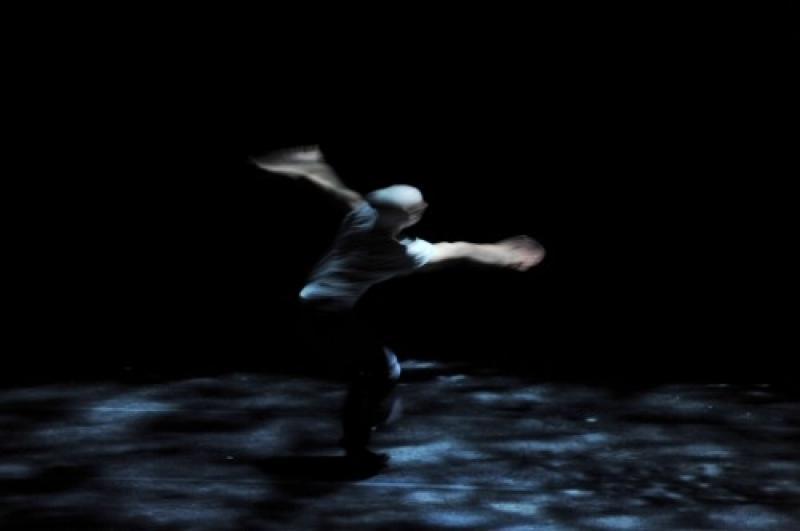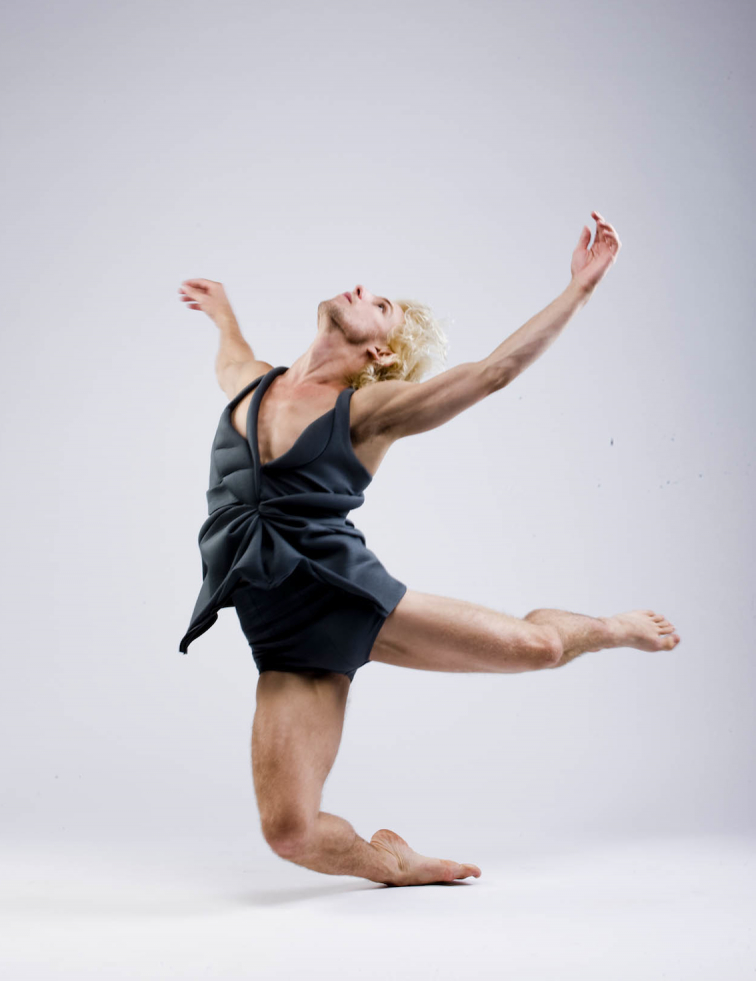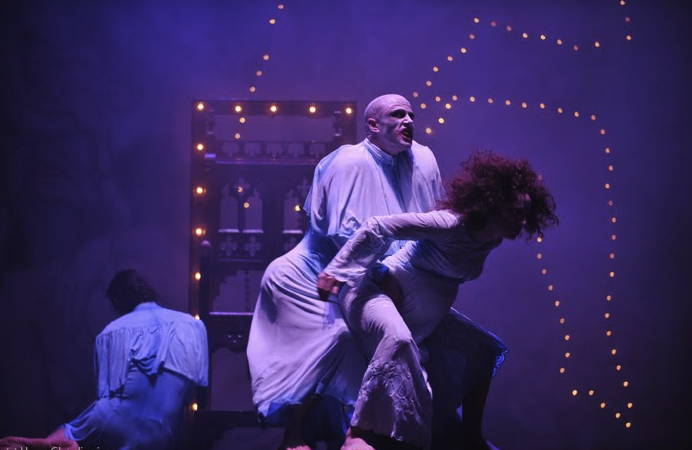In the Spirit of Diaghilev, Sadler's Wells | reviews, news & interviews
In the Spirit of Diaghilev, Sadler's Wells
In the Spirit of Diaghilev, Sadler's Wells
Polluted Popes, polar explorers, naive Fauns - everything from succès to scandale

Where to start with reviewing the "Diaghilev" evening of new choreographies at Sadler’s Wells last night? With the cool clean head of Wayne McGregor’s or the hot poxed genitals of Javier de Frutos’s? Well, as it’s a 100th birthday party for Diaghilev's iconoclastic Ballets Russes, there’s no harm in pointing out that the poxed genitals are an awful lot more amusing (with the accent on awful) than the familiar McGregorian chant of BSc theses to swot up while watching his dances.
I have nothing against cerebral good taste, especially with the calibre of stage partners offered here by McGregor in Dyad 1909 (the clever scientific term for a pair). The best thing for me was the luxury packaging, with some gorgeous video projections of rotating machinery and snowy wastes by Jane and Louise Wilson, some cute black Swarovski crystal masks worn over Gap-style vests and pants, and a furry Antarctic explorer loitering about like a polar bearer. The explorer is presumably Ernest Shackleton, whose South Pole expedition took place just as Diaghilev was throwing open the Pandora’s Box of dance theatre that was the Ballets Russes.
McGregor’s imagination seems to me to be wired constantly to circuit-boards, gives me nothing to sense
There is also Olafur Arnalds' music for string quartet, piano and electronics of perfect dis-locational atmosphere, with a childish computer voice reminiscent of Stephen Hawking. There are duets in which the male-female dyad dance like brilliantly capable humanoids, twitch and pivot on tiny spots, poke their bottoms out pertly and flap their arms behind them in that weird proclamatory style adopted by girl gymnasts on the beam, and relate to each other not at all. McGregor’s imagination seems to me to be wired constantly to circuit-boards, gives me nothing to sense, no surprises.
By contrast Russell Maliphant’s magical whirling solo, AfterLight, is all quiet, full sensation. It is a true homage to Nijinsky, an original and individual piece that conjures up the spirals and circles of the superstar’s serene, vivid drawing of a dancer's motion, made when he had lost his wits. Ninette de Valois recalled how remotely happy Nijinsky looked when allowed out from his sanatorium for a rare visit to his old company, and it’s light, serenity and the poignant contentment of solitude that glow from the astounding Daniel Proietto’s dervish-like spinning and falling. His costume, white skullcap, red bomber jacket and blue jeans, seems in the twilight to channel the sawdust puppet Petrushka, a signature Nijinsky role.
 Michael Hulls’ cascade of dappled, altering light surrounds him, traps him between worlds. Satie’s soft, insistently doodling piano Gnossiennes suit the choreography, casting a mesmerising spell.
Michael Hulls’ cascade of dappled, altering light surrounds him, traps him between worlds. Satie’s soft, insistently doodling piano Gnossiennes suit the choreography, casting a mesmerising spell.
Nijinsky in another of his signature roles, as the Faune, inspired Sidi Larbi Cherkaoui to make a duet for his own faun, the goat-nimble James O’Hara (photographed by Diego Franssens), and the solid tree-goddess of Daisy Phillips. Debussy’s opening flute and string phrases tease some gawky, coltish tumbles for the Faun, stretching his limbs awkwardly, unfurling his spine sensuously, like a baby animal being born.
The intriguing jolt when Debussy’s sylvan flute is interrupted by Nitin Sawhney’s dark, mooing Asian pipes wasn’t equalled, for me, by the choreography for Phillips, who is as sturdy as a tree but not O’Hara’s equal in stage presence. Once the pair come together, things look up, with some sharp synchronised parallel display followed by soft, rough couplings like very inexperienced teenagers in love. Naivety is a tricky thing to capture in dance, but Cherkaoui got it for me by the end.

He's created a deliberate scandale, in the hopes of a succès de. He gets half of it anyway
Which brings us to the none-too-naive Javier de Frutos, and his creation of a deliberate scandale, in the hopes of a succès de. He gets half of it anyway. Eternal Damnation to Sancho and Sanchez is the outraged, outrageous, but also (alas) rather half-cock creation of an extrovert South American Roman Catholic gay whose past masterpieces have included nude solos to Bartok (Meeting J), blood-soaked bedroom horrors (Grass) and a hauntingly beautiful version of Rite of Spring (Milagros), a man who will never forgive his church for not loving him the way he loves it.
In that this is a personal tragedy for de Frutos, he is entitled to the feverish violence with which his satirical ballet slashes out at a monstrous misshapen Pope who assaults and abuses all around him from his altarboy to the pregnant women in his flock. (Pictured above by Hugo Glendinning/SWT)
De Frutos seems to have shot his wad, though, on his merrily ridiculous scenario, a hommage to Jean Cocteau, and leaves too little imaginative energy over for his choreographic efforts, which is a pity. But he is such an entertaining theatrical cove and so is his designer, Katrina Lindsay. There is fabulously naughty wallpaper surrounding the action, of gigantic nude males in a state of urgent Renaissance alertness.
Diaghilev’s famous mantra, "Amuse me", in neon lights, descends. In Javier's hands this might as well be "Abuse me". It’s all as jawdroppingly yeurghy as the Circus of Horrors, and has been calculated to a tee to provoke walkouts and boos from the audience.
- Performing until Saturday. Book online here
- Ismene Brown interviews Maliphant, Cherkaoui and de Frutos about their pieces here
- Read what happened to Javier de Frutos afterwards in a Q&A Special on theartsdesk (2011)
Explore topics
Share this article
The future of Arts Journalism
You can stop theartsdesk.com closing!
We urgently need financing to survive. Our fundraising drive has thus far raised £33,000 but we need to reach £100,000 or we will be forced to close. Please contribute here: https://gofund.me/c3f6033d
And if you can forward this information to anyone who might assist, we’d be grateful.

Subscribe to theartsdesk.com
Thank you for continuing to read our work on theartsdesk.com. For unlimited access to every article in its entirety, including our archive of more than 15,000 pieces, we're asking for £5 per month or £40 per year. We feel it's a very good deal, and hope you do too.
To take a subscription now simply click here.
And if you're looking for that extra gift for a friend or family member, why not treat them to a theartsdesk.com gift subscription?
more Dance
 Help to give theartsdesk a future!
Support our GoFundMe appeal
Help to give theartsdesk a future!
Support our GoFundMe appeal
 The Forsythe Programme, English National Ballet review - brains, beauty and bravura
Once again the veteran choreographer and maverick William Forsythe raises ENB's game
The Forsythe Programme, English National Ballet review - brains, beauty and bravura
Once again the veteran choreographer and maverick William Forsythe raises ENB's game
 Sad Book, Hackney Empire review - What we feel, what we show, and the many ways we deal with sadness
A book about navigating grief feeds into unusual and compelling dance theatre
Sad Book, Hackney Empire review - What we feel, what we show, and the many ways we deal with sadness
A book about navigating grief feeds into unusual and compelling dance theatre
 Balanchine: Three Signature Works, Royal Ballet review - exuberant, joyful, exhilarating
A triumphant triple bill
Balanchine: Three Signature Works, Royal Ballet review - exuberant, joyful, exhilarating
A triumphant triple bill
 Romeo and Juliet, Royal Ballet review - Shakespeare without the words, with music to die for
Kenneth MacMillan's first and best-loved masterpiece turns 60
Romeo and Juliet, Royal Ballet review - Shakespeare without the words, with music to die for
Kenneth MacMillan's first and best-loved masterpiece turns 60
 Vollmond, Tanztheater Wuppertal Pina Bausch + Terrain Boris Charmatz, Sadler's Wells review - clunkily-named company shows its lighter side
A new generation of dancers brings zest, humour and playfulness to late Bausch
Vollmond, Tanztheater Wuppertal Pina Bausch + Terrain Boris Charmatz, Sadler's Wells review - clunkily-named company shows its lighter side
A new generation of dancers brings zest, humour and playfulness to late Bausch
 Phaedra + Minotaur, Royal Ballet and Opera, Linbury Theatre review - a double dose of Greek myth
Opera and dance companies share a theme in this terse but affecting double bill
Phaedra + Minotaur, Royal Ballet and Opera, Linbury Theatre review - a double dose of Greek myth
Opera and dance companies share a theme in this terse but affecting double bill
 Onegin, Royal Ballet review - a poignant lesson about the perils of youth
John Cranko was the greatest choreographer British ballet never had. His masterpiece is now 60 years old
Onegin, Royal Ballet review - a poignant lesson about the perils of youth
John Cranko was the greatest choreographer British ballet never had. His masterpiece is now 60 years old
 Northern Ballet: Three Short Ballets, Linbury Theatre review - thrilling dancing in a mix of styles
The Leeds-based company act as impressively as they dance
Northern Ballet: Three Short Ballets, Linbury Theatre review - thrilling dancing in a mix of styles
The Leeds-based company act as impressively as they dance
 Best of 2024: Dance
It was a year for visiting past glories, but not for new ones
Best of 2024: Dance
It was a year for visiting past glories, but not for new ones
 Nutcracker, English National Ballet, Coliseum review - Tchaikovsky and his sweet tooth rule supreme
New production's music, sweets, and hordes of exuberant children make this a hot ticket
Nutcracker, English National Ballet, Coliseum review - Tchaikovsky and his sweet tooth rule supreme
New production's music, sweets, and hordes of exuberant children make this a hot ticket

Add comment